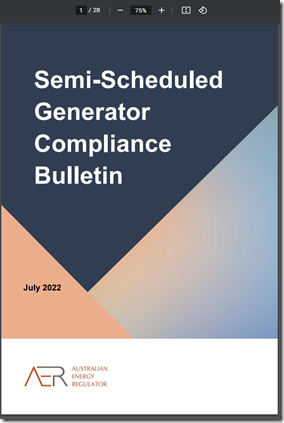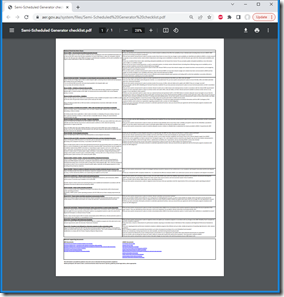Catching up on a bit of activity in regulatory space of the NEM, we noted that (on 1st July 2022) the AER published new Semi-Scheduled Generator Compliance Bulletin, and new Checklist. On this page they noted:
‘The AER’s Semi-Scheduled Generator (SSG) compliance bulletin outlines to SSGs our expectations regarding compliance with a number of critical obligations under the National Electricity Rules. While these expectations are mostly similar to those for Scheduled Generators, there are some differences due to the reliance of SSGs on specific weather conditions as a fuel source.
This compliance bulletin sets out key obligations of SSGs relating to various functions such as registration, operational forecasting, dispatch, communication, and the provision of data. It sets out examples of what we consider to be good practice approaches to compliance, which we strongly encourage participants to adopt. The related checklist contains several tasks that may assist market participants to achieve compliance and provides links to relevant supporting procedures published by the AER and AEMO.
Participants should review their practices in light of the information set out in the bulletin and checklist, and update them as appropriate.
The information in the bulletin and checklist is provided for guidance only and is not an exhaustive list that guarantees compliance. Market participants will need to make a commercial decision about how best to operate, guided by private legal advice, where appropriate.’
… and linked to these two documents:
| Semi-Sched Generator Compliance Bulletin |
Semi-Sched Generator Checklist |
|---|---|
|
The 28-page Compliance Bulletin is here:
|
The 1-page Checklist is here: |
|
As frequent readers of WattClarity® will have noted, we’ve been wondering for a while whether the Semi-Scheduled category is either/both scalable and sustainable into the future (for instance on 9th July 2020, 17th July 2020, 24th July 2020, and on other occasions) In several of the Appendices within GenInsights21 recently we explored different aspects of this question in considerable detail. (e.g. Appendix 17, and Key Observation 13). It seems to us that the AER is striving to do what it can through Bulletins like these to give the category the greatest chance of being both scalable and sustainable: 1) So it would seem reasonable to expect that both existing and prospective new Semi-Scheduled generators would read and adopt what’s being asked for in this Bulletin 2) Because if this is not done, it would seem to make it more likely that the decision might be made that the category is not scalable or sustainable … as a result of which Wind and Solar Farms might be required again to be fully Scheduled (with the associated costs – but also the benefits – of that). So communications like these are important. Take for instance this paragraph from p6/28: ‘The technology used by participants in their operations is also evolving. In recent years, the AER has observed increased adoption by participants of automated systems serving a variety of functions in their operational processes. The reliance on these automated systems, in the absence of additional controls to adequately monitor and respond to market conditions, may in some cases fall short of achieving compliance with relevant obligations under the NER. Examples of how automated systems should be supported are provided in sections 2.4 and 2.5 of this bulletin.’ This ‘rise of the auto-bidder’ was something discussed in my presentation to CEC Large Solar Forum on 19th May…. and also in GenInsights21 (Part 2 Key Observation 13/22) More broadly, from p18 the document contains this contrast between Non-conformance and Non-compliance: ‘Non-conformance is an AEMO dispatch process. Conformance monitoring is a process that AEMO uses to identify and implement corrective measures if a Market Participant fails to follow a dispatch instruction. It automatically flags non-responsive Semi-Scheduled. Generating units based on the SCADA quantities used by the central dispatch process. The intention of the non-conformance process is to ensure non-complying plant don’t impact price signals. Non-compliance refers to the AER’s assessment of participant compliance with dispatch instructions under NER 4.9.8(e). It is important that participants understand that not being flagged by AEMO as non-conforming does not necessarily indicate compliance with dispatch instructions. The AER’s Compliance Bulletin No.1 contains additional information on the AER’s compliance and enforcement approach to registered participants’ obligations to follow dispatch instructions, including a distinction between non-compliance with dispatch instructions and being declared as non-conforming by AEMO’ … which reminds me of this article from 8th December 2020 ‘Conformance and compliance – what’s the difference?’ |
It’s only a single page, but is it small type and does flag a significant number of Tasks/Expectations well worth reading to ensure generators are aware of what the AER is asking you to do. For instance, these two jumped out at me… ‘Where you have automated systems in place to actively monitor and submit offers, bids and rebids, are there relevant personnel available to actively monitor and act on any changes or errors identified in these systems? Where you have automated systems in place, have you rostered technical and operational staff in a 24/7/365 fashion to maintain adequate manual oversight to ensure that the generating unit or load can comply with the latest market offer at all times? Do you have relevant personnel available to actively monitor generator output, offers and correct input of bid/rebid reasons and plant availability information? If utilising automated bidding systems, do you have systems, processes and personnel in place to ensure that all offers and rebids comply with overarching obligations around the provision of high quality and accurate information to AEMO and the market. ’ These are some of the reasons why we were involved in providing initial seed funding to help start Overwatch Energy as a business designed to provide that 24x7x365 day oversight by people who are all Australian-based and knowledgeable in the requirements of the AER and AEMO in this respect. We’ve been pleased with the rapid growth of this business since its early days to the point where it has a very significant volume of generation (and other services) under management. |
I trust that sharing this update from the AER here will prove of value.




Be the first to comment on "AER published ‘Semi-Scheduled Generator Compliance Bulletin and Checklist’"